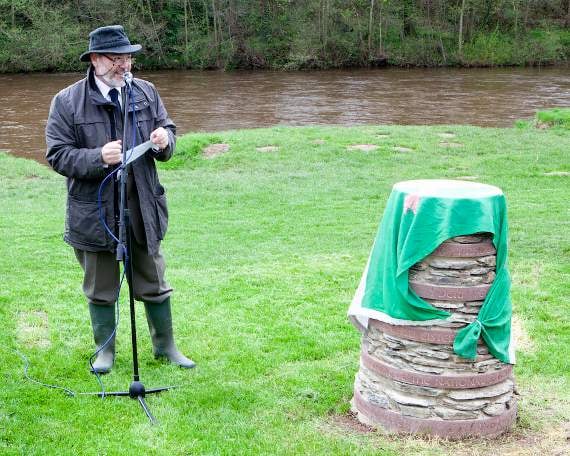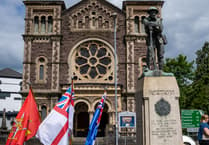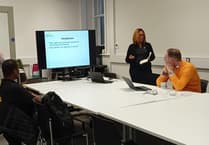A CROWD watched an April shower break into sunshine as Abergavenny cemented its legacy as host of the National Eisteddfod with an unveiling of a ceremony stone.
Around 100 people, including local councillors, dignitaries, Eisteddfod representatives and schoolchildren, gathered on Castle Meadows for the memorial last Wednesday.
Mayor David Simcock opened the event, welcoming Frank Olding whom he described as ‘integral’ to the successful project to bring the Eisteddfod to Abergavenny after a century-long absence.
Mr Olding, a representative of the Eisteddfod Committee, delivered a speech praising Abergavenny’s ‘hugely successful’ hosting of the National Eisteddfod back in 2016, adding that seminal event’s legacy had stoked a resurgence in Welsh culture and support for the Welsh language.
School children from a selection of local primary schools punctuated the ceremony with assured and confident displays — discussing their own feelings about Welsh culture, and leading the throng in renditions of Welsh choir song.
One young boy from Llanfoist Primary School received a rapturous applause after his mention of the Welsh national rugby team being his most prideful aspect of his own Welshness.
Surveyed by S4C camera crews, the ceremony listened intently as Christine James, former archdruid of the Gorsedd, relaying the ‘important and vital history’ of Abergavenny in the development of the Eisteddfod.
‘The decision to invite Abergavenny to host the Eisteddfod was indeed a brave one,’ she said. ‘And even braver was the decision to accept the invitation, given Monmouthshire’s anglicised status and proximity to the border.
‘The National Eisteddfod held on this ground, in 2016, was a huge success. But the legacy of that event is what has had the most positive impact,’ she continued.
‘Today, we unveil this celebratory stone to celebrate that success. I sincerely hope the legacy will not depend just upon this stone, but on the impact the Eisteddfod has on Welsh language and culture.
Council leader Peter Fox, added that the ‘real legacy’ would be developed through ‘these school children who have worked so hard’. ??‘The Eisteddfod was one we all shall never forget, and although we are traditionally an Anglicised community, we are, all of us, truly Welsh.
‘These young people here today, have shown us all why we work so hard to strengthen and celebrate Welsh language and Welsh culture,’ he added.
Abergavenny’s Mayor Simcock revealed the stone — a hive-like mound of stone and iron banding — with the help of a young girl named Martha Turner, daughter of stonemason Jane Turner. ??As sunshine flooded Castle Meadows, Michael Orsmond, Pastor at Abergavenny Baptist Church, blessed the celebratory stone, as all present joined in prayer, before joining in the national anthem.
But the monument has not been universally welcomed, some Abergavenny residents have taken to social media to express their opinions with one stating, ‘It’s ugly, what relevance does have to the Eisteddfod?’
While another commented, ‘It wont be long before its covered in graffiti; waste of money. The only people who see it are the dog walkers.’
However, in the monument’s defence, one poster added, ‘Some will like it, some won’t, purely a matter of design taste. The important part is what it represents and it’s brilliant that the enjoyment and pride in our language is so obvious in and around Abergavenny. It’s inoffensive. Hope we all enjoy it on our walks.’
Promoters of the Welsh Language in Monmouthshire have been heartened by the proliferation of interest in Welsh that has come in the wake of the Eisteddfod.
Sarah McGuinness, chairperson of Menter Iaith, stated she was delighted with the interest shown in the unveiling of the commemorative stone, adding that the organisation welcomed all initiatives which help build on the legacy of the Eisteddfod.
‘We would be more than happy to offer help with organising and co-ordinating any future events.’ she said.





Comments
This article has no comments yet. Be the first to leave a comment.